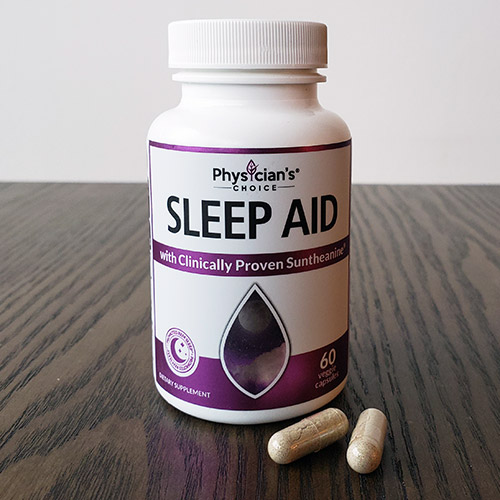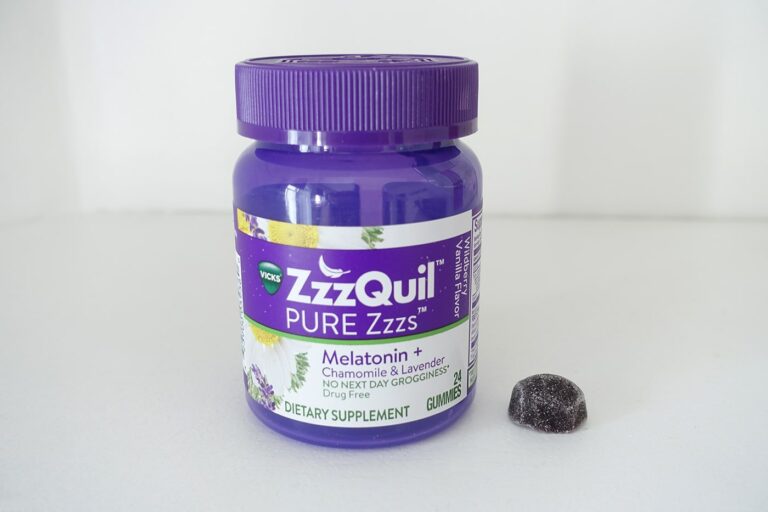
Disclosure: This review is based on my personal experience of taking the Sominex sleep aid, and you may have a different experience. Please discuss taking any new sleep aid with a healthcare professional rather than only relying on online sources.
Updates: I first wrote this article in 2018 when I tried Sominex. The most recent update in 2024 was to edit the warnings and side effects listed when I bought it as they may have changed over time.
The different types of Sominex
It’s important to understand that there are different versions of Sominex.
I bought the one I’ll be discussing in this review in the UK, which listed promethazine hydrochloride as the active ingredient. I took the photo above of the box I got.
When I was living in the US, I saw a version of Sominex that has diphenhydramine as the active ingredient instead of promethazine. They are both antihistamines, but they aren’t the same.
Sominex also makes a herbal sleep aid, which I tried in the UK. I also wrote about that version in my Sominex Herbal review. At the time, it contained valerian, hops, and passionflower.
Sominex is made by a company called Teva UK. Their website tevauk.com (not a sponsored or paid link) has a section about both versions of Sominex. It includes a medical information email address if you have questions about it.
My experience
With the unbearable mugginess of a rare British heatwave turning my bedroom into a nighttime sauna, I’d had several bad nights’ sleep in a row.
I bought a pack of Sominex from Boots chemist in the UK, where it’s available over the counter and online without a prescription. I took my first pill on a Sunday night, an hour before bedtime, in the hope it would put a stop to the sweaty sleeplessness.
I went to bed shortly after taking it and stayed up reading a book. When I first take a new sleep aid, I’m always curious to see if I notice any effect, such as feeling drowsy. Reading in bed gives me a good opportunity to keep an eye on how I’m feeling.
After about 45 minutes, I remember starting to feel quite drowsy. I put my book down, turned off the light, and I believe I fell asleep in around 5 to 10 minutes.
A good night’s sleep
I only woke up once in the night, which was markedly different from the previous few nights. I remember feeling quite out of it, i.e. disorientated. I had a sip of water and quickly fell asleep again.
I then woke up around eight hours later, which is unusual for me, even on the best of nights. I normally have at least two or three memorable wakings. Could it be that the Sominex had worked well for me then?
Morning grogginess
I definitely didn’t wake up feeling 100% alert. My head felt cloudy, in a similar way to when I took the antihistamine version of Nytol.
It wasn’t so bad though and after a strong coffee and a refreshing shower, I was probably at about 80% of my normal alertness.
That slightly groggy feeling slowly subsided over the next few hours, and by mid-morning, I was pretty much back to normal.
Testing again the following night
Another hot night and another Sominex pill to see how it would work two days in a row. Once again, I could feel the sedative effect creeping in just under an hour after taking it. I slept through the night, with no wakings that I could recall.
I also realised that I normally get woken at least once by insanely noisy seagulls around 5 a.m.! So it was interesting that I managed to sleep through their boisterous cacophony.
The fuzzy head appeared again though, and as with the previous day, it lasted into the mid-morning before losing the battle to strong coffee.
My conclusion
My overall feeling is that Sominex worked for me. Of course, I need to be mindful of the potential for the placebo effect to have played a role, or other factors that I’m not aware of. And the way I judged how well I slept was based on my subjective feeling rather than proper testing, which is always an issue when I try a sleep aid.
Having said that, I personally don’t feel that it was just a placebo effect. I’ve had similar experiences with other antihistamines, while the herbal sleep aids I’ve taken feel different.
I decided not to take it on the third night, however, because I didn’t want any more morning grogginess. The temperature dropped a little anyway, which made it easier to sleep naturally.
Having a cloudy head in the morning after taking an over the counter sleep aid is something I’ve experienced on numerous occasions. I don’t particularly like not waking up feeling alert and needing time to get going. It’s one of the main reasons I’m unlikely to take an antihistamine sleep aid like this one regularly.
Further information
Listed ingredients in 2018
The following information is taken from the patient leaflet that came with the box of Sominex that I bought from a Boots chemist. The manufacturer may change the ingredients over time.
- Promethazine hydrochloride 20mg.
- Lactose.
- Maize starch.
- Croscarmellose sodium.
- Magnesium stearate.
Warnings and potential side effects
It’s always wise to check with your doctor or a qualified healthcare provider that a sleep aid is safe and appropriate for you to take, even if it’s available online or over the counter. They can give you personalised advice rather than relying on the brief description on a box or label.
The leaflet that came with my box of Sominex had lists of potential side effects, warnings over which groups of people should not take it, and possible drug interactions to be aware of. I won’t list them all in this article because they may change over time and I don’t want anyone reading this to think it’s an exhaustive list.
So, just to reiterate, please consult a healthcare practitioner before deciding to take Sominex to check that it’s safe and appropriate for you personally.
I’ll also link to some online resources in the further reading section below so you can do some additional reading about Sominex and using antihistamines as sleep aids. There’s a lot more publicly available information about the ingredient promethazine and antihistamine sleep aids in general than there is specifically about Sominex.
Further reading
Medicines.org.uk – they have information about Sominex and a scanned pdf of the patient leaflet.
NHS – UK healthcare service has a section on Sominex/promethazine.
Drugs.com – has a section on Sominex
Research in 2021 – addresses concerns around unsafe antihistamine use in England.
Consumer Reports – a long article about the problem with sleeping pills.
Research in 2000 – looks at issues with older people using certain medication, including antihistamines like promethazine.
Wikipedia – this entry explains the different types of Sominex and their history.
My sleep hygiene article – I discuss natural ways to sleep, with lots of practical tips.




